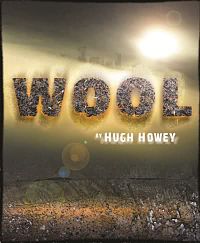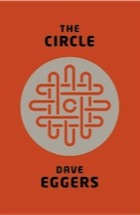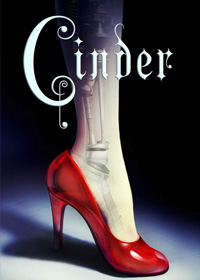Previously self-published e-books Wool, Wool 2, Wool 3, Wool 4, and Wool 5, make up this 500+ page compilation by author Hugh Howey. It is no small undertaking to read; however, it was well worth it. After piddling slowly through the first book (originally a 40 page short story), I got a notice from the library that it was due and could not be renewed, so I read all day yesterday until 2:30 this morning to finish. In a post apocalyptic future, several thousand people are living in a cement silo that bores nearly 150 stories into the ground. Goods and information and bodies are all moved via a single spiral staircase. The various levels contain a handful of administrative offices (mayor, sheriff, deputies), a few cafeterias, clinics/nurseries, hydroponic farms, animal pens, fabrication facilities, IT, and in the lowest levels is "Mechanical" where are found the oil well, the mines, the generator, the pumps, and the people who maintain them. We open the story with a ritualized death by Cleaning. No one is allowed to say anything about the outside--wondering about it or voicing a desire to go there. The only view of the bleak and utterly desolate remains of earth (presumably) come from sensors that extend above the ground. Large screens on the top floor of the silo show this view in the cafeteria, and in the holding cell of the jail. Whenever someone is convicted of any crime, they are given wool pads, a suit to protect them from the toxic air, sent outside to clean the sensor lenses. In living memory, no one has ever returned from this task. the view of the sere brown hills, and the skeletal city remains in the distance is punctuated by the decomposing bodies of those sent out to clean. When a popular and long-standing sheriff volunteers to go "out," the Mayor and deputy sheriff seek a mechanic from the "down-deep" to replace him. Reluctant new sheriff Juliette is obsessed with finding out why Sheriff Holston voluntarily went outside to his death. Since it turns out that IT, not the popularly elected Mayor has secretly been running the whole show in the silo, they quickly determine that Juliette is a menace and must die. Before she is sentenced to clean, however, she figures out that IT has been engineering the deaths of people and through close friends in Mechanical she gets a suit that does not fail and walks out of view over the hills where she discovers another silo. This is a well-developed plot with interesting characters, and my only niggling complaint is that we are supposed to believe that it gets colder the further down you bore into the earth--probably not! Otherwise, the science seems realistic and the resolution is satisfying. Other post-apocalyptic novels I have enjoyed include The Postman (Brin), Into the Forest (Hegland), and A Gift Upon the Shore (Wren)--almost all set in the Pacific Northwest. Now there is something to ponder.
Keeping track of what I read by jotting down my reactions, providing information about the author, and linking to additional reviews. And occasional notes on other book related things...
Sunday, December 29, 2013
Thursday, December 26, 2013
The Circle
Monday, December 16, 2013
The Gunslinger: The Dark Tower I
Monday, December 9, 2013
Cinder
It would be bad enough losing your shoe at the ball, but to lose your whole foot!--Now that would be seriously problematic. Marissa Meyer has written a futuristic version of Cinderella with a cyborg (human being augmented by mechanical/electrical parts) as her heroine, Linh Cinder of New Beijing. Set in a future after World War IV, the world has reassembled into 6 political units, with the Eastern Commonwealth being one of them. Cinder lives here with a nasty step-mother, two step-sisters, Pearl and Peony. Only Peony and the family droid, Iko, seem to have any affection for Cinder. Step-mother Adri blames Cinder for the death of her husband, who insisted they adopt Cinder after her life-saving surgery. But cyborgs are treated as 2nd class citizens on Earth, and in spite of Cinder's uncanny skills repairing anything mechanical or electrical--skills that provide the family's only income--Adri and Pearl are embarrassed about being associated with Cinder. Plans are underway to attend the annual palace ball when Peony contracts the plague that has been devastating the earth's population in recent years. Cinder gets the blame for that as well, and Adri "volunteers" Cinder to be a subject for unfailingly fatal research on antidotes for the plague. But Cinder does NOT die, and a whole new set of problems now present themselves. Of course the parallel storyline is that the somewhat unorthodox Prince Kai has personally brought his royal droid to Cinder for repairs, claiming it is a matter of national security. The emperor has contracted the plague and if he dies, Kai will become Emperor. The Queen of Luna would very much like to get a foothold on earth through a marriage to Kai, but nobody on earth really wants that to happen. Then she offers a cure for the plague--the day after the Emperor dies. There is clearly a sequel(s) in the works, as Cinder warns Prince Kai of an imminent threat to his life, but forfeits her own freedom, and possibly her life, in the process.
Wednesday, December 4, 2013
The Paris Architect
Author Charles Belfoure is a real live architect so his perspective on German-occupied Paris during the early 1940's reflects his passion for the buildings and the structure of the city itself. Lucien, a struggling architect who sat out France's defense at the Maginot Line, which the Germans adroitly circumvented, does not consider himself to be a brave man or a fool. And only one or the other would choose to have anything to do with Jews at this point in time when the Gestapo are relentlessly hunting them down and shooting anyone who even lives in the same building as a Jew. When Manet, an aristocrat turned industrialist, comes to Lucien asking him to devise a hiding place that can't be found by the Gestapo, Lucien turns him down flat. Manet, however, promises not only a sizable sum of money, but the opportunity to build his next big factory, which at this time in the war, would be providing armaments for the Germans. Lucien is a modernist, a fan of Gropius and the Bauhaus movement, hence much reviled in a city that reveres classic architecture. He agrees more out of a desire to get his big break and do something that will demonstrate his talent, although the money does allow him to buy scarce food on the black market. Swearing each time that it will be his last, Lucien continues to build cleverly disguised hiding places, outwitting the Gestapo, and so becoming their target. With his marriage already on the rocks, Lucien's wife leaves him, accusing him of being a collaborator--an architect who has sold his soul to the devil. His denial and revelation that he has been helping hide Jews only adds to her scorn. Even Lucien's beautiful mistress, Adele, has abandoned him in favor of a powerful member of the Gestapo who can get scarce fabrics to supply her fashion design business. Because of Lucien's activities, a Catholic priest who has been aiding Jewish children, brings a boy to him, ostensibly for a short time, but the priest is captured and disappears forever into Gestapo headquarters. Lucien finds he likes being a surrogate father for Pierre. Bette, Adele's second in command, it turns out, is also hiding Jewish children, and when Lucien designs a hiding place in her apartment that saves their lives, she falls fully in love with him. As the noose draws tighter, Lucien's unlikely friendship with a German engineer buys him the resources to escape across the Swiss border with Bette and the 3 children. I thought the writing at times was a bit clunky, and the ending way too tidy, although goodness knows there was plenty of torture and violence prior to this. The book is most interesting for its portrayal of neighbor turning against neighbor when fear is expertly manipulated. There is a map in the front material so you can follow the action through the streets of Paris.
Labels:
architecture,
France,
historical novels,
Jews,
Paris,
thriller,
WWII
Subscribe to:
Posts (Atom)




